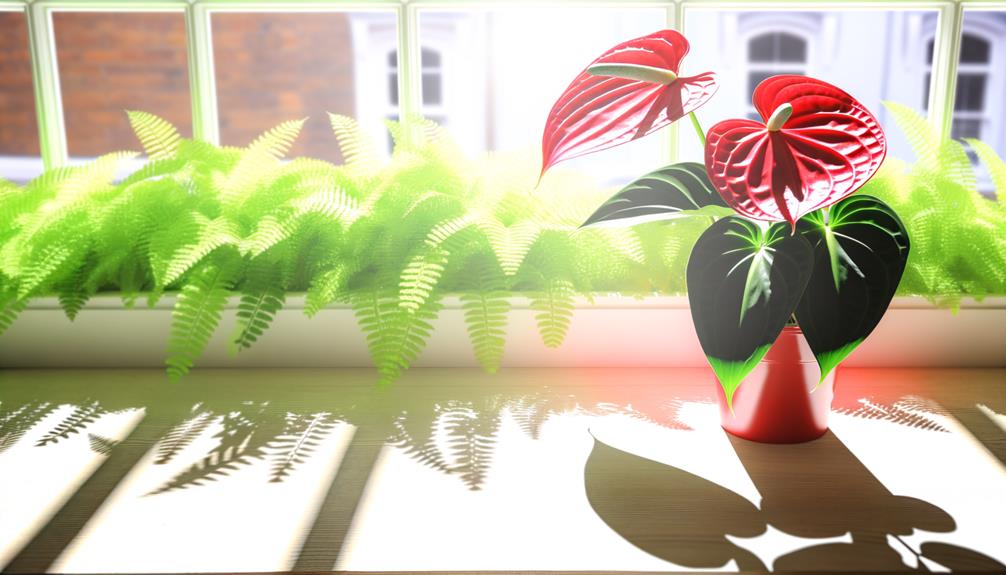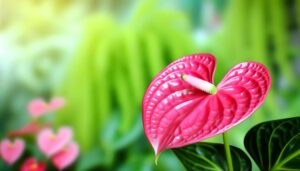5 Essential Tips for Caring for Anthurium Red
To care for your Anthurium Red, place it in bright, indirect light to prevent leaf scorching and rotate it weekly for uniform exposure. Water when the top inch of soil is dry, using tepid, dechlorinated water, and ensure proper drainage to avoid anaerobic conditions.
Use a well-aerated soil mix rich in organic matter with good drainage, and maintain a pH of 5.5 to 6.5. Keep humidity at 70-80% and temperatures between 65-80°F (18-27°C) during the day.
Prune regularly with sterilized shears to encourage healthy growth and manage pests. For a detailed guide, there’s more to discover.

Key Takeaways
- Place Anthurium Red in bright, indirect light to prevent leaf scorching.
- Water when the top inch of soil is dry to avoid overwatering.
- Use well-aerated soil rich in organic matter for optimal growth.
- Maintain 70-80% humidity and stable temperatures between 65-80°F (18-27°C).
- Regularly prune with sterilized shears to remove spent flowers and leggy growth.
Optimal Light Conditions

For best growth, place your Anthurium Red in an area where it receives bright, indirect light to prevent leaf scorching and ensure proper photosynthesis. Make sure the light source is diffused, such as through sheer curtains or by positioning the plant near an east-facing window.
Avoid direct sunlight, which can cause photodamage, leading to chlorosis and necrosis of leaves. Utilize a light meter to maintain an ideal light intensity of 10,000 to 20,000 lux. Rotate your Anthurium Red weekly to guarantee uniform light exposure and balanced growth.
If natural light is insufficient, use full-spectrum LED grow lights set on a 12-hour photoperiod. Regularly monitor light conditions to sustain your plant’s vibrant foliage and strong flowering potential.
Proper Watering Techniques
Guarantee your Anthurium Red thrives by watering it thoroughly when the top inch of soil feels dry to the touch, maintaining a consistent moisture level without causing waterlogging. Utilize tepid, dechlorinated water to avoid root shock and chlorosis.
Pour water evenly across the soil surface, ensuring deep saturation. Allow excess water to drain completely, preventing root rot by avoiding stagnant water in the saucer.
Monitor ambient humidity, aiming for 60-80%, as high humidity supports transpiration and nutrient uptake. If humidity drops, consider misting or using a humidity tray.
Avoid overwatering, which can lead to anaerobic conditions and fungal pathogens. Consistency is key; establish a regular watering schedule based on environmental conditions and plant response, adjusting as necessary.
Ideal Soil Composition

To secure ideal growth, select a well-aerated soil blend rich in organic matter and perlite, promoting exceptional drainage and root health.
Begin with a foundation of pine bark or coconut coir, as these ingredients offer excellent aeration and root support.
Incorporate sphagnum peat moss to improve moisture retention and supply essential nutrients.
Add perlite to the blend for enhanced drainage and to prevent soil compaction.
Ensure the soil pH stays between 5.5 and 6.5 for peak nutrient uptake.
Blend in a small amount of charcoal to purify impurities and enhance root aeration.
Avoid dense, clay-based soils, as they hold onto excessive moisture, leading to root rot.
Routinely check soil texture to uphold the ideal balance of moisture and aeration.
Humidity and Temperature
Maintaining ideal humidity and temperature is just as crucial as selecting the right soil blend, ensuring that the Anthurium Red thrives in its environment. Aim for a relative humidity of 70-80%. You can achieve this by misting the plant or using a humidifier.
The best temperature range is 65-80°F (18-27°C). Avoid sudden temperature fluctuations, as these can stress the plant. Here’s a quick reference table:
| Parameter | Ideal Range |
|---|---|
| Humidity | 70-80% |
| Day Temperature | 65-80°F (18-27°C) |
| Night Temperature | 60-70°F (16-21°C) |
Keeping these parameters in check fosters robust growth and vibrant blooms, ensuring your Anthurium Red remains a stunning focal point in your home.
Pruning and Maintenance

Regularly pruning your Anthurium Red not only promotes healthier growth but also enhances its aesthetic appeal by removing dead or yellowing leaves. Use sterilized pruning shears to make clean cuts at the base of the affected leaves, minimizing the risk of infection.
Focus on cutting back any leggy or spindly growth to encourage bushier development. Additionally, remove spent flowers to redirect the plant’s energy towards new blooms.
Inspect the plant weekly for pest infestations; early detection and removal are essential. After pruning, dispose of all plant debris to prevent fungal spores from spreading.
How to Get More Red Heart Leaves in Anthurium
To get more red heart leaves in Anthurium, follow these steps:
- Light: Provide bright, indirect light. Avoid direct sunlight, which can scorch the leaves.
- Watering: Keep the soil consistently moist but not waterlogged. Water when the top inch of soil feels dry.
- Humidity: Maintain high humidity levels (60-80%). Use a humidifier or place the plant on a tray with water and pebbles.
- Fertilizing: Feed with a balanced, water-soluble fertilizer every 4-6 weeks during the growing season.
- Temperature: Keep the temperature between 70-85°F (21-29°C). Avoid cold drafts.
- Soil: Use well-draining, rich organic soil with good aeration.
- Pruning: Remove old or yellow leaves to encourage new growth.
By optimizing these conditions, you can promote the growth of vibrant red heart leaves in your Anthurium.
Conclusion
By mastering these tips, you’ll transform your anthurium red into the botanical marvel of your home!
Bathe it in filtered sunlight, quench its thirst precisely, root it in nutrient-rich, well-draining soil, maintain that ideal humidity and temperature, and meticulously prune for unparalleled health.
Your anthurium won’t just survive, it’ll thrive with unprecedented energy, becoming the envy of every plant enthusiast.
Follow these steps, and watch your anthurium red flourish like never before!






